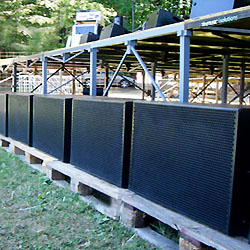Visceral, deep, percussive, tight, punchy – just some of many words used to describe bass response. A prominent low end forms the foundation for many styles of music and helps get the audience moving.
Subs are specialized loudspeaker cabinets, typically operating somewhere inside the range between 20 Hz and 150 Hz, and they usually cross over into the full-range mains around 100 Hz. Especially toward the bottom of the range, these LF sounds are felt in the body as much as they’re heard as a distinct pitch, with the area between 20 to 40 Hz often called sub-bass.
Many popular instruments center around bass frequencies, with the low E on a bass guitar or upright having a fundamental of 41 Hz, the lower notes of a synth, piano, or five-string bass going down to 31 Hz or below, and the thump of a kick drum focusing a lot of energy around 60 Hz.
To meet the requirements of reproducing LF at higher sound pressure levels, most of the enclosures are physically large and densely constructed, often housing a pair of 15-inch or 18-inch (and sometimes bigger) cone drivers. Yet even for their size and weight, they’re dwarfed by the lengths of the sound waves they must reproduce.
A 40 Hz tone, for example, measures over 28 feet to complete a single cycle. Given the ratio of wavelength to cabinet size, the resulting audio output tends to propagate omnidirectionally, though technologies are available to control (at least somewhat) directionality.
Subs are designed using several basic principles. The most common design utilizes one or more direct-radiating cone drivers in a tuned, ported “bass reflex” enclosure. Also widely used, a folded horn design places a cone driver within the interior of the enclosure, and it feeds a baffled “horn” pathway that exits the front. The tapped horn is a variant that modifies the location of the driver within the horn.
Bandpass designs resemble enclosures within an enclosure, where cone driver(s) in sealed or vented internal cabinets fire into a second tuned chamber before the sound exits, reducing upper harmonics while presenting a controlled LF bandwidth. Designers will sometimes use more than one of these principles to create hybrid subwoofers, such as a blended direct-radiating and bandpass cabinet.
Cardioid designs present more acoustic energy toward the audience area while reducing output toward the rear. They typically have one or more forward-facing drivers, combined with a rear-firing driver whose output is modified in time via physical positioning and delay, so that the combined sound waves tend to attenuate or cancel at the sides and back.
Multiple enclosures can also be combined in various ways to create directivity, usually with some of the cabinets turned to fire toward the rear. Alternately, individual cabinets may have their polarity reversed (some models provide switches or other internal settings for this purpose), or their output is electronically delayed to create the desired pattern of summation and cancellation away from the stage and toward the listeners. The multiple subs within these arrays also couple to effectively create a much larger source relative to the longer LF soundwaves.
Other aspects to consider include the placement of subs relative to the mains, output level, LF extension to meet the requirements of the music, the ability to accurately reproduce the audio sources they’re reinforcing (transient and frequency response), and minimizing harmonic interference between the output of the subs and the low-mids of the mains.
Ultimately, the subs chosen and how they’re used is dictated by the needs of the music and what the listeners expect. At Electro-Voice, I was part of a group proposing tunes to highlight the low end of a particular sub. I preferred an acoustic instrumental with an upright bass solo ending on a powerful, sustained low E that could be felt as well as heard. A co-worker chose a dance tune with a kick drum punch that to my ears sounded like beating on a cardboard box. In the end we used both, since one highlighted the musicality and the other imparted impact.
Our Photo Gallery Tour (here) includes more than two dozen subwoofer models in a variety of formats. In addition, ProSoundWeb offers several informative articles that lend further understanding, including “Moving Air: Inside Subwoofer Designs and Configurations” by Craig Leerman and “What Really Defines Good Bass in Sound Reinforcement” by Jeff Berryman. Well worth your time.
Gary Parks is a pro audio writer who has worked in the industry for more than 25 years, holding marketing and management positions with several leading manufacturers.















